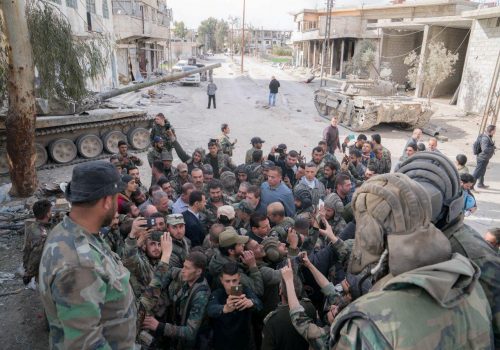Pity the nation: Assessing a half century of Assadist rule
Fifty years ago, on November 13, 1970, Hafez al-Assad seized power from rival factions of the ruling Baath Party. Dubbed the “corrective revolution” by his new regime, Assad’s coup d’état represented the defeat of a leftist faction and the ascent of party moderates. Yet few imagined at the time that this seizure of power by a disgruntled officer—one of a long string of similar coups in a country notorious for its instability—would mark the beginnings of the longest period of continuous family rule in Syria’s modern history.
When Bashar al-Assad succeeded his father after Hafez’s death in June 2000, Syria entered an exclusive club. There are fewer than a half-dozen republics in which presidencies have been handed down directly from father to son. Of these, there are only three countries in the world in which father-son duos have held the presidency uninterrupted for a half century or more: Togo, Gabon, and Syria. In all three cases, sons who inherited their presidencies have prevailed in multiple, if highly suspect, elections and, as of this writing, remain in power.
The exceptional longevity of the Assad regimes is noteworthy. It also raises a question made all the more relevant by the past decade’s upheaval: what, precisely, have fifty years of Assadist rule accomplished? When Bashar al-Assad ascended to power at the age of thirty-four—his path paved by a docile parliament that hurriedly amended the constitution to lower the minimum age for the presidency—he inherited a stagnant backwater of a country. Though his father was often lauded for his strategic and diplomatic acumen, by the time Hafez al-Assad died in June 2000, he had achieved little more than overseeing his country’s drift into irrelevance.
He also failed in his lifelong ambition to assert Syria’s centrality in regional affairs. Henry Kissinger’s well-known dictum, “you can’t make war in the Middle East without Egypt and you can’t make peace without Syria,” was proven wrong with the signing of the Camp David Accords in 1979. That same year, Syria was added to the then newly created US list of state sponsors of terror (it is the only one of the original designees to remain on the list to this day). No longer able to play a decisive role as spoiler and, with the Palestinian cause languishing, Hafez al-Assad’s periodic forays into Arab-Israeli diplomacy made no discernable headway.
A wasted decade later, the Soviet Union collapsed and the region’s diplomatic center of gravity had begun shifting eastward to the Arab Gulf, casting Syria even further to the margins of regional politics. At the end of his second term and only months before Hafez died, Bill Clinton was the last American president to invest diplomatic capital in an effort to broker a Syrian-Israeli peace. He too failed. Hafez al-Assad’s much vaunted “strategic patience” exhausted his adversaries yet did nothing to advance Syria’s interests or secure the return of the Golan Heights. This national aspiration has since moved even further out of reach.
Bashar’s domestic inheritance was on even shakier ground. While the country had survived a crippling economic crisis in the mid-1980s, it entered the twenty-first century with a moribund economy, an inefficient bureaucracy, a weak and vastly overstaffed public sector, degraded educational and healthcare sectors, and among the highest unemployment levels in the world. The security sector, however, had thrived under Hafez, prospering from Syria’s occupation of Lebanon while ensuring the regime’s survival through its brutal suppression of the 1979-1982 insurgency of the Muslim Brotherhood, culminating in the infamous Hama massacre in February 1982.
By all accounts, Hafez al-Assad was largely indifferent to economic matters, allegedly once describing economics as a subject for donkeys. Bashar could not afford to emulate his father’s disinterest. Like many dictators, Hafez viewed Syria’s public budget as an instrument of regime survival. He allocated resources and opportunities—including the opportunity to benefit from rampant corruption—to cultivate loyalist networks that favored regime insiders but extended well beyond them to encompass significant segments of the Damascene Sunni business elite.
Hafez’ “corrective revolution” was premised on the partial unwinding of the radical economic policies favored by his predecessor, Salah Jadid. Yet the elder Assad largely preserved Syria’s “authoritarian bargain,” offering Syrians tenuous economic security in exchange for political quiescence—a form of coercive dependence that preserved a precarious social peace. The modest economic reforms initiated during his last decade proved inadequate to pull Syria out of its economic torpor. Instead, reforms merely opened new horizons for the corrupt enrichment of regime insiders and well-connected businessmen.
When Bashar stepped into the presidency in July 2000, Syria’s GDP had at long last recovered to the levels achieved in the early 1980s. In the subsequent decade, the economy seemed to thrive. Per capita GDP doubled between 2000 and 2010, as the country transitioned to what officials described as a “social market economy.” Not far below the surface, however, the regime was driving Syria toward a break point. While the world focused on the political arena—Bashar’s short-lived “Damascus Spring” (the brief political opening of 2000-2001), his elimination of internal rivals, his open-door policy for jihadists moving into Iraq, his role in the assassination of former Lebanese Prime Minister Rafik Hariri, followed by Syria’s humiliating eviction from Lebanon—the social and economic costs of deep, systemic dysfunctions were growing.
Despite Bashar’s efforts to upgrade and modernize authoritarianism in Syria, top-level economic growth left the vast majority of Syrians behind. During his first decade in power, poverty deepened and unemployment grew, especially among youth. In 2006, severe drought gripped Syria’s agricultural zones, its effects amplified by mismanagement and corruption. Over the next few years, hundreds of thousands of small farmers were forced off their land and became environmental refugees who settled on the outskirts of Damascus and provincial capitals, like Deraa in Syria’s south. Regime cronies, led by Assad family members, such as Rami Makhlouf, became increasingly rapacious, preying on and alienating the business community that had previously lent its support to the regime. Makhlouf reportedly ended up controlling some 65 percent of Syria’s economy.
For his part, Bashar seemed to think that his fealty to the tenants of Arabism and “resistance,” though far more rhetorical than real, were sufficient to insulate his regime from the wave of protests that swept through the region beginning in late 2010. He was wrong. By March 2011, with the examples of Egypt, Tunisia, and Libya fueling their aspirations, Syrians, too, overcame the “wall of fear,” found their collective voice, and joined in mass protests calling for economic and social justice and an end to the Assad regime. Confronted with an unprecedented challenge—the withdrawal of consent and legitimacy by millions of ordinary Syrians—the regime responded with force, setting the country on the path to civil war.
Today, after a decade of conflict, Bashar sits atop the wreckage of a country, his position salvaged but not yet fully secured by Russia and Iran’s intervention. The exigencies of survival have left their own dismal impact on the country: a shattered economy, fractured society, and mass socialization into norms of violence, sectarian intolerance, and extremism. War unleashed the most thuggish of the regime’s appetites, further entrenching its brutality and corruption. Wartime profiteers and warlords now boldly assert their prerogatives as Syria’s new political elite, reaping the rewards of their support for the Assads over the past decade.
As Syrians contemplate a fraught transition to post-conflict and the likely imposition of an authoritarian peace, the enduring legacies of Assadist rule are best expressed in what have become dual and utterly separate realities. Images of Bashar triumphant, Makhlouf’s sons with their luxury cars and private jet, and Asma al-Assad comforting widows in her designer jeans, appear alongside starkly different images of long, parallel rows of white shrouds, bread lines, children picking through garbage dumps, and overcrowded boats carrying Syrians into uncertain futures as refugees.
The Syrian uprising is a more damning referendum on the Assad family legacy than any judgement that might be rendered by outsiders. Its defeat has come at a terrible price. Generational projects of reconstruction and social repair lie ahead, challenges the regime is singularly ill-equipped to meet and that may yet shake its grip on power. The Assads and their loyal supporters, however, acknowledge no such possibilities. In 2028, Bashar, should he still be in power, will bump up against presidential term limits established in 2012. Perhaps, in anticipation of that moment, the family is grooming his eldest son, Hafez Bashar al-Assad, to ascend to the presidential throne. The Assads are not done with Syria yet. Pity the nation.
Steven Heydemann holds the Ketcham Chair in Middle East Studies at Smith College where he directs the Middle East Studies Program. He is also a nonresident senior fellow in the Center for Middle East Policy at the Brookings Institution.
Image: Kinana al-Bunni, 37, a female taxi driver, exercises in Damascus, Syria October 3, 2020. Pictures of Syria's president Bashar al-Assad and his father late former president Hafez al-Assad, are seen in the background. Picture taken October 3, 2020. REUTERS/Yamam Al Shaar


